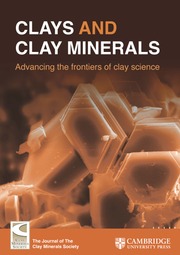Article contents
A Review of the Reactivity of Phosphatase Controlled by Clays and Clay Minerals: Implications for Understanding Phosphorus Mineralization in Soils
Published online by Cambridge University Press: 01 January 2024
Abstract
Mineralizable macronutrients (e.g. C, N, P, and S) are sorbed readily (i.e. adsorption and precipitation) in clays and clay minerals. Phosphorus (P) is one of the limiting macronutrients in soils because both phosphate and organic P undergo chemisorption in soil minerals. Furthermore, phosphatases that mineralize the organic P species tend to partition into soil minerals, suppressing the interactions between organic P and phosphatase. Adsorbed phosphatase on the mineral surfaces can regulate the enzyme activity and influence the biochemical properties of the enzyme (e.g. kinetics, conformation, and stability), affecting the P cycle in the terrestrial environment. Phosphatase–mineral interactions are widely reported to decrease the enzyme activity while enhancing the enzyme stability (e.g. thermal and proteolysis stability). Contradictory findings have also been reported. Specific enzymes, mineral characteristics, and reaction conditions are probably responsible for various reactivity (e.g. mineralization). The purpose of the present review was to summarize current and past investigations of acid and alkaline phosphatase sorption in clays and clay minerals and to examine phosphatase chemical properties (e.g. kinetic activity, thermal and proteolysis stability) and factors (e.g. pH, saturating cations of the mineral, enzyme structure, and mineral surface polarity) influencing the phosphatase-mineral interaction. Lastly, also reviewed is the application of phosphatase–mineral interactions with some expansion to other enzymes as an indication of potential future application for phosphatase and future research needs.
- Type
- Review
- Information
- Copyright
- Copyright © The Author(s), under exclusive licence to The Clay Minerals Society 2023
Footnotes
Associate Editor: Chun-Hui Zhou
References
- 9
- Cited by


